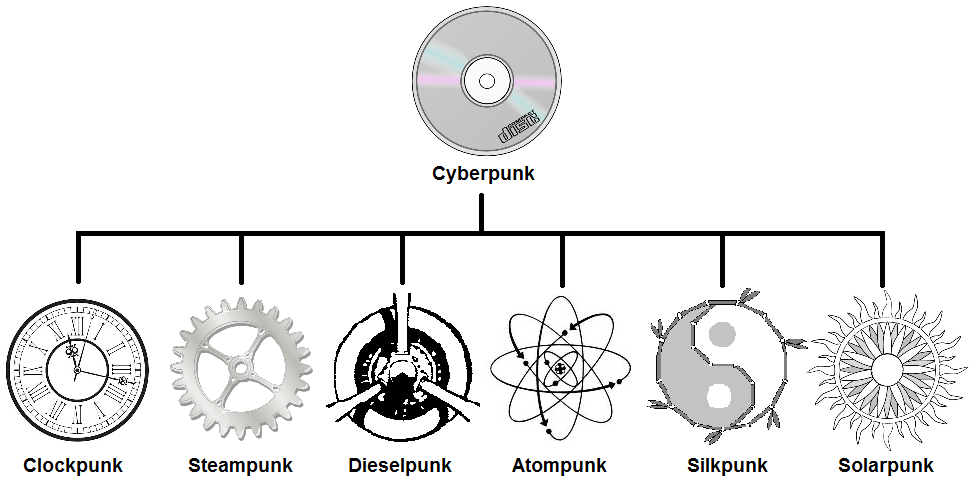The Punk Family just keeps on growing! Its new addition is Solarpunk, a subgenre and movement pointed out to me by a kind fan on Facebook.

The Punk Family started with Cyberpunk, which spawned a series of literary subgenres. Of those, the most popular is Steampunk (a favorite of mine). Most of them are marked by a prime mover, an energy source or main motivating agent, that is part of each one’s name. They all incorporate a ‘punk’ aspect, that is, that at least one character rebels against some aspect of society. Finally, each one comes with its own décor, or visual style and clothing design.
As near as I can determine, Solarpunk started with a post by Olivia Louise in 2014. She envisioned a world of renewable, sustainable, ecological green energy where people are closer to the earth and specialize as craftspeople and artisans. She proposed an aesthetic along Art Nouveau lines.
Others took up this theme and incorporated related threads of thought into Solarpunk, including:
- Transcendence beyond war, aggressive violence, and scarcity;
- A culture celebrating ethnic and sexual diversity and inclusion;
- A decentralized society, including micro-farming, with individuals not dependent on a commercial, global economy to furnish their needs;
- A technology level we already have; no new breakthroughs required; and
- Glass structures and ubiquitous solar cells.
Solarpunk is a reaction against a society marked by the burning of fossil fuels, hierarchal political arrangements, corporate greed, global warming, intolerance of marginalized groups, capitalism, and globalism. That, of course, is the ‘punk’ aspect of Solarpunk.
Given this description, you can understand the appeal of this movement. A quick internet search for ‘solarpunk’ reveals beautiful designs incorporating flowers and other plants, and utopian depictions of a near future within our reach.
Some great descriptions of the Solarpunk movement include posts by Connor Owens, Adam Flynn, and Ben Valentine. Goodreads has a list of Solarpunk literature here.
Solarpunk is still blossoming and forming itself. Its literary landscape is rather sparse, and there’s a clear demand for more Solarpunk stories. This represents a new and potentially fruitful opportunity if you’re a writer of fiction, like—
Poseidon’s Scribe

In case you want more info, check out this post at Medium: https://medium.com/solarpunks/solarpunk-a-reference-guide-8bcf18871965
Also, there is a twin “punk” called lunarpunk that is more night-focused than solarpunk. It’s a much smaller community, but it’s an important counterpoint to the overarching brightness of colors and such of solarpunk. I would say it’s color palette is an optimistic cyberpunk.
Thank you, Solarpunk Gnome, for visiting my site, and for the comments. I hadn’t heard of Lunarpunk, but I suspected the Punk family would continue to expand. I’ll do a post on Lunarpunk in the near future.
Is solarpunk the new word for ecopunk? At least solarpunk sounds better.
A couple of other punks: Teslapunk, biopunk, and nanopunk.
In a green future, I think buildings made from diamond like materials would make more sense than glass buildings, based on this article (nanotechnology is also environmental friendly technology): https://web.archive.org/web/20010512220607/https://www.dse.nl/~hkl/e_nano1.htm
Stories that focus on green technology can be great, but I also think it would be interesting if all this is taken for granted and serve as the background for the story. Once our own society with places, internet and satellites was science fiction. Novels talking place in our own time mostly use our civilization as a backdrop for the story since everybody is taking it for granted.
And personally I don’t see the need to include for instance “celebrating ethnic and sexual diversity and inclusion”. If it is an essential ingredient you should of course include it, but not making it mandatory for a sci-fi subgenre unless it is a subgenre where these elements are required. And since the “punk-genres” focus on technology and not sexual orientation and ethnicity, it should be up to the authors what they want to include or not.
Well said, Hansen, and thanks for commenting. You’ve touched on two interesting aspects of all the -punk literature. First, how, as an author, do you make the technology just part of the backdrop, and yet familiarize the reader with it? Second, are specific social aspects necessarily part of a technological movement? In a work of fiction, you want to immerse your readers in your ‘world,’ and that includes the non-technological facets. Those who thought up solarpunk specifically wanted diversity to be part of it. Of course, nothing stops you from writing about a world of solarpunk tech, but with a social milieu of your choosing.